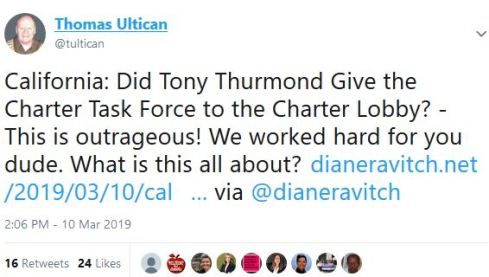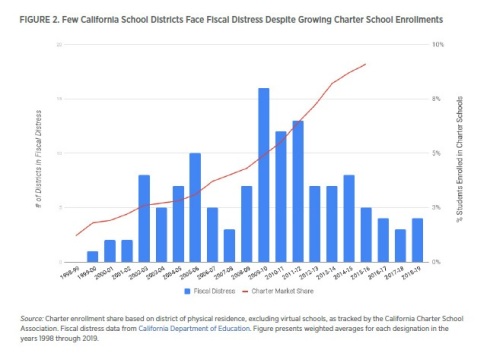By T. Ultican 6/15/2019
California Governor Gavin Newsom created a task force and assigned the State Superintendent of Public Instruction (SSPI), Tony Thurmond, to lead a review of California charter school laws and policies. The Center on Reinventing Public Education (CRPE) produced three policy briefs and CRPE founder Paul Hill testified to the task force as an expert witness “sympathetic to charter schools.” The author of “Breaking Point,” Gordon Lafer also provided expert testimony.
Rutgers Professor Bruce Baker reviewed Hill’s claims which were published in three CRPE policy briefs created for the taskforce. Spoiler alert: He found them deceptive.
Thurmond released “The Charter School Policy Task Force” report to the Governor on June 6.
The claims by these scholars and political actions coming from the task force have the potential to influence the spending of hundreds of millions of dollars in public monies by California and billions in spending by the federal government.
The Charter School Policy Task Force (CTF)
The task force was made up of eleven members. Since 90% of the California’s students attend public schools and because the charter industry spent more than $50 million to defeat SSPI Thurmond in 2018, many people expected supporters of public schools to dominate the task force. But that was not the case. Jan Resseger observed,
“It is one of those groups carefully balanced to provide a forum for both sides of what has become a contentious debate about whether or not there ought to be a charter school sector. Actually whoever recommended the appointments seem to have accepted the idea that the fight is between unions and charter schools—an assumption I believe is wrong, because the debate is not limited to the fact that fewer teachers in charter schools belong to teachers unions.”
Others like Diane Ravitch saw the committee in terms of the charter school industry versus public schools. She wrote, “By my count, six members of the 11-member panel are directly connected to the charter industry, including two from the lobbying organization CCSA.” A seventh member of the elevenmember task force also appears to be biased toward privatization. The seven pro-privatization members were:
- Cristina de Jesus, president and chief executive officer, Green Dot Public Schools California. This was the same charter system failed SSPI candidate Marshall Tuck previously led.
- Margaret Fortune, California Charter Schools Association board chair; Fortune School of Education, president & CEO.
- Lester Garcia, political director, SEIU Local 99. Closely associated with Eli Broad. Most recently they took $100,000 from Broad to oppose Jackie Goldberg for LA Unified School District Board.
- Beth Hunkapiller, educator and administrator, Aspire Public Schools. A charter school chain.
- Ed Manansala, superintendent, El Dorado County and board president, California County Superintendents Educational Services Association. Diane Ravitch reported, “… Ed Manansala was principal and superintendent of Kevin Johnson’s St. Hope Academy Charter High School in Sacramento before he became County Superintendent in El Dorado.” His El Dorado County Office set up a Special Education Local Plan Area (SELPA) specifically to service students with disabilities in charter schools and wooed charter students away from their local districts.
- Gina Plate, vice president of special education, California Charter Schools Association.
- Edgar Zazueta, senior director, policy & governmental relations, Association of California School Administrators. During the last election cycle his organization endorsed former charter school executive Marshall Tuck for SSPI.
The other four members – which also included the only two members with classroom teaching experience – were:
- Dolores Duran, California School Employees Association.
- Alia Griffing, political director, American Federation of State, County and Municipal Employees (AFSCME) Council 57.
- Cindy Marten, superintendent, San Diego Unified School District. (A former teacher)
- Erika Jones, board of directors, California Teachers Association. (A current teacher serving on the union board)
The immediate response to this committee was anger directed at SSPI Thurmond for the task force makeup. Capital and Main reported, “No sooner did author-academic Diane Ravitch expose this month the charter leanings of Governor Gavin Newsom’s task force studying the fiscal impacts of charters than California schools superintendent and panel chair Tony Thurmond found a Twitter blowtorch pointed his way.” My tweet was part of that blowtorch.

A few days later on March 14, Diane Ravitch posted,
“I received an email from a reader in California whose credentials are impeccable, who has a direct tie inside the Governor’s office. This person told me that the committee was selected by Governor Gavin Newsom, not by Tony Thurmond.”
It is not likely that Newsom personally selected the committee members. It is highly probable that Newsom’s new Chief of Staff, Ann O’Leary, a former advisor to Hilary Clinton, selected them. A Fortune magazine biography of O’Leary noted,
“O’Leary is a diehard policy wonk, especially keen on anything that affects families or education. As Clinton’s Senate aide in 2001, she was at the center of No Child Left Behind—a once popular education initiative that has since soured in the public mind. ‘It was a really important moment,’ she says of the law, which Ted Kennedy crafted and George W. Bush signed. ‘When you look back at what happened, this was serious, bipartisan, constructive work. We were committed to high standards and helping states get there.”’

Ann O’Leary – Policy Runner Blog Mount Holyoake College 2016
O’Leary appears to be a heartfelt social liberal who had a key voice in promoting gay rights and paid maternity leave. However, besides her history with NCLB, she supports Common Core State Standards and says they were developed by state governors. She believes in standards based testing and supports privatizing public education with charter schools. She is a neoliberal from the Clinton wing of the Democratic Party. Her professional position and past actions provide strong evidence that she selected the members of the task force.
The CTF Work Product
To begin their work, the CTF received a series of reports on charter schools and their impacts from a variety of sources. Thurmond called this “an attempt to provide some level setting for members to establish a baseline of understanding and knowledge.” Once “level setting” was complete the CTF began brainstorming policy reform proposals. The task force was able to reach consensus on four proposals, reported majority voting support for seven proposals and two proposals did not receive majority support.
Proposals not receiving majority support reflect the impact of giving the charter industry a majority position on the task force.
A California law (Education Code 47605 [b]) states, “the governing board of the school district shall grant a charter for the operation of a school if it is satisfied that granting the charter is consistent with sound educational practice.” Because of the word “shall,” if the proposal is educationally sound few other considerations are relevant and the charter must be granted. The proposal was to replace the word “shall” with “may.” This change could add to the difficulty in obtaining a charter especially in districts already impacted by charters, therefore it failed. SSPI Thurmond wrote, “The proposal to change from ‘shall’ to ‘may’ failed by the narrowest of votes, with the majority position opposing the change.”
A managed growth plan that would control growth in highly impacted districts like Los Angeles, San Diego and Oakland did not make it to a vote. Thurmond reported, “CTF members were invited to provide an alternative set of caveats for a managed growth plan, however CTF members could not agree on the conditions for limiting growth.”
Current charter school law requires using Academic Performance Index (API) testing data to determine whether a charter school has met the academic testing criteria for renewal. A proposal to update the charter law to reflect that API is no longer used got majority support but not consensus. Why?
There was majority support for ending charter denial appeals to the state, limiting appeals to the county to errors by the district, prohibiting authorization of charters outside district boundaries, allowing fiscal impact to be considered in charter authorization and developing clearer authorization guidelines.
There was consensus agreement that the state department of education should not supervise charters and that school saturation, academic outcomes and statements of need should be part of the authorizing process. There was also consensus that districts losing students to charter schools should receive the same hold harmless provisions a district receives when a student moves out of the area. This $100,000,000 proposal would help mitigate some of the losses districts face when charters are expanding in their area.
The other two consensus proposals add thirty days to the time a district has to respond to a charter petition and create statewide authorizer standards and training.
Center on Reinventing Public Education (CRPE) is a Propaganda Mill
Scholar, Bruce Baker reviewed the three policy briefs by CRPE for the National Education Policy Center at the University of Colorado. His paper “Costs, Benefits, and Impact on School Districts (Center on Reinventing Public Education, May 2019)” begins,
“The Center on Reinventing Public Education (CRPE), based at the University of Washington, Bothell, recently released a series of three policy briefs on the financial impact of charter schools on nearby school districts in California. The briefs arrive at a time when a Task Force convened by California Gov. Gavin Newsom is deliberating on these exact matters. CRPE’s founder, Paul Hill, was a key source of testimony to the task force, serving as an expert viewed as ‘sympathetic to charter schools.”’
John Chubb’s and Terry Moe’s 1990 book, Politics, Markets, and America’s Schools, claimed that poor academic performance was “one of the prices Americans pay for choosing to exercise direct democratic control over their schools.”
Responding to Chubb and Moe, Rand Corporation researcher Paul Hill founded the Center on Reinventing Public Education (CRPE) and began working out the mechanics of ending democratic control of public education. His solution was the portfolio model of school governance.
The portfolio model directs closing schools that score in the bottom 5% on standardized testing and reopening them as charter schools or Innovation schools. In either case, the local community loses their right to hold elected leaders accountable, because the schools are removed from the school board’s portfolio. It is a plan that guarantees school churn in poor neighborhoods, venerates disruption and dismisses the value of stability and community history.
In July of 2018, former Enron trader, John Arnold, joined forces with San Francisco billionaire Netflix CEO, Reed Hastings. They each pledged $100,000,000 to a new non-profit dedicated to selling the portfolio model of school governance. They call it City Fund. Gates and Dell have also contributedto City Fund.

Big Money Flowing to the Portfolio Model and Public School Privatization (Map here)
Hill’s presentation to the CTF had little to do with scholarly research and everything to do with promoting the privatization of public education. In his review, Professor Baker goes into a detailed refutation of the CRPE assertions. He concludes,
“The first brief is misleading in its assertion that charter enrollment growth is not to blame for district enrollment decline. It is, and has been for some time, whether in districts with declining, stable or growing overall student enrollments. The brief also attempts to minimize the import of the considerable role played by charters in districts’ enrollment loss, offering up the non sequitur that enrollment loss can arise from other sources as well. The second brief relies on overly simplistic comparisons of charter enrollments and county-assigned “fiscal distress” classifications to conclude that there is no association between charter enrollments and fiscal distress. The contention here is that there can’t be an illness if the patient isn’t dead. In order to rely on this problematic approach, the brief erroneously dismisses a significant, more rigorous, detailed, peer-reviewed and published body of research that illustrates the fiscal impact of charter schools on host districts, and how those fiscal impacts may lead to fiscal stress. The third brief, which presents itself as an analysis of costs and benefits, merely touts the benefits of charter schooling as tangible while being entirely dismissive of numerous known and often measurable costs. Taken together, the briefs are useful only in pointing to some important issues that policymakers should consider; their analyses of those issues are, however, generally superficial and misleading.” (emphasis added)

CRPE Graph Showing Fiscal Distress Decreased as Charter Enrollment Increased
Baker’s amusing analysis of this proof that charter schools are not causing fiscals distress says,
“Of course, what Figure 2 actually shows is that the recessionary period from 2008 through about 2013 resulted in a dramatic increase in districts in fiscal distress, which has subsided during the recovery period, swamping any noticeable effects of charter growth and making it impossible to draw any conclusions regarding charter enrollment impact from this broad descriptive data.”
“It’s also true, however, that between 1960 and 2000, the rate of cigarette smoking among women declined by about 30%, while during the same time period, the rate of death from lung cancer increased more than 50%. Should we logically conclude that stopping smoking causes lung cancer? Or might there be other factors at play?”
It seems clear that CRPE is not producing scholarly information. They are simply creating propaganda to sell the billionaire financed positions.
Some Charter School Reform Proposals
After 25-years, it is obvious that the charter school experiment is a failure. Charter schools have been a net harm to public education in America. There has been almost no innovation coming from the charter school sector with the exception of regressive practices such as “no excuses” discipline policies. It is a sector that is rife with profiteering, fraud and abuse. The best charter schools merely match the better public schools and on average charters do worse on testing than public schools.
The charter system adds a layer of inefficiency to public education and creates division in communities. As Peter Greene wrote again yesterday in his blog Curmudgucation,
“The problem here, as with several other choice-related issues, is in a false premise of modern school choice movement. That false premise is the assertion that we can fund multiple school districts for the same money we used to use to fund one single public system.
“This is transparent baloney.”
Charter school reform proposal 1: A complete and permanent moratorium on new charter schools.
Charter school reform proposal 2: Role all existing charter schools that choose not to become private schools into the school district within which they reside.
No comments:
Post a Comment
Note: Only a member of this blog may post a comment.